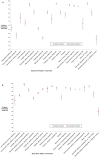Validity of myocardial infarction diagnoses in administrative databases: a systematic review
- PMID: 24682186
- PMCID: PMC3969323
- DOI: 10.1371/journal.pone.0092286
Validity of myocardial infarction diagnoses in administrative databases: a systematic review
Abstract
Background: Though administrative databases are increasingly being used for research related to myocardial infarction (MI), the validity of MI diagnoses in these databases has never been synthesized on a large scale.
Objective: To conduct the first systematic review of studies reporting on the validity of diagnostic codes for identifying MI in administrative data.
Methods: MEDLINE and EMBASE were searched (inception to November 2010) for studies: (a) Using administrative data to identify MI; or (b) Evaluating the validity of MI codes in administrative data; and (c) Reporting validation statistics (sensitivity, specificity, positive predictive value (PPV), negative predictive value, or Kappa scores) for MI, or data sufficient for their calculation. Additonal articles were located by handsearch (up to February 2011) of original papers. Data were extracted by two independent reviewers; article quality was assessed using the Quality Assessment of Diagnostic Accuracy Studies tool.
Results: Thirty studies published from 1984-2010 were included; most assessed codes from the International Classification of Diseases (ICD)-9th revision. Sensitivity and specificity of hospitalization data for identifying MI in most [≥50%] studies was ≥86%, and PPV in most studies was ≥93%. The PPV was higher in the more-recent studies, and lower when criteria that do not incorporate cardiac troponin levels (such as the MONICA) were employed as the gold standard. MI as a cause-of-death on death certificates also demonstrated lower accuracy, with maximum PPV of 60% (for definite MI).
Conclusions: Hospitalization data has higher validity and hence can be used to identify MI, but the accuracy of MI as a cause-of-death on death certificates is suboptimal, and more studies are needed on the validity of ICD-10 codes. When using administrative data for research purposes, authors should recognize these factors and avoid using vital statistics data if hospitalization data is not available to confirm deaths from MI.
Conflict of interest statement
Figures


References
-
- Health statistics and informatics department, World Health Organization (2011) Causes of Death 2008 Summary Tables. Available: http://www.who.int/healthinfo/global_burden_disease/estimates_regional_2.... Accessed 2014 March 10.
-
- Leal J, Luengo-Fernandez R, Gray A, Petersen S, Rayner M (2006) Economic burden of cardiovascular diseases in the enlarged European Union. Eur Heart J 27: 1610–1619. - PubMed
-
- Mensah GA, Brown DW (2007) An overview of cardiovascular disease burden in the United States. Health Aff (Millwood) 26: 38–48. - PubMed
-
- Gonzalez A, Maradit Kremers H, Crowson CS, Ballman KV, Roger VL, et al. (2008) Do cardiovascular risk factors confer the same risk for cardiovascular outcomes in rheumatoid arthritis patients as in non-rheumatoid arthritis patients? Ann Rheum Dis 67: 64–69. - PubMed
-
- Kuo CF, Yu KH, See LC, Chou IJ, Ko YS, et al. (2013) Risk of myocardial infarction among patients with gout: a nationwide population-based study. Rheumatology (Oxford) 52: 111–117. - PubMed
Publication types
MeSH terms
LinkOut - more resources
Full Text Sources
Other Literature Sources
Medical

